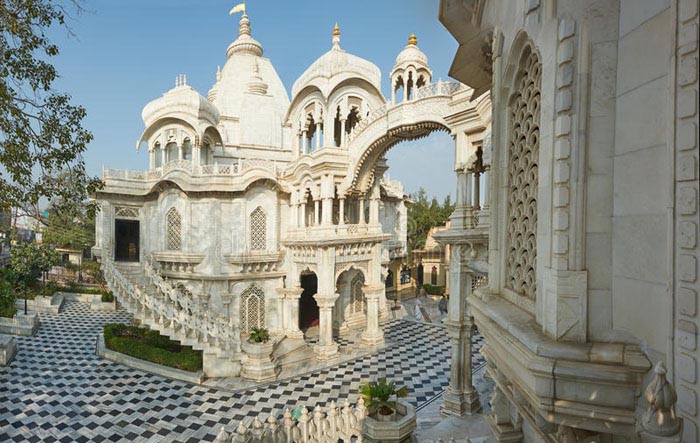ISKCON Temple Vrindavan

Information of ISKCON Temple, Vrindavan, Mathura, Uttar Pradesh
International Society for Krishna Consciousness or ISKCON was created by Bhaktivedanta Swami Prabhupada in the year 1966. ISKCON Temple is also known as Krishna Balaram Mandir which is located in Raman Reti of Vrindavan, where lord Krishna demonstrated his mystical pastimes, about 5000 years ago. At present, ISKCON Temple is considered as one of the most renowned temples in entire Vrindavan.
ISKCON Temple Vrindavan Religious Significance
The immediate objective of the creation of ISKCON Temple was to promote the teachings of Bhagwad Gita as well as the Vedic scriptures and hence, to create an apparent awareness about lord Krishna in the mind of devotees. The aim of ISKCON Temple is to direct people towards a simple yet clean and otherworldly life. ISKCON Temple belongs to Vaishnavism, which is a religious tradition, created on the basis of the instructions of Gita.
The principles and religious activities of ISKCON Temple were taught and categorised in 15th century by popular spiritual reformer Chaitanya, his brother Nityananda and his six key associates named Goswamis. Devotees recognise Chaitanya as the direct embodiment of god Krishna who gave a powerful stimulus for enormous religious movement throughout India. Under his direction multiple volumes on the philosophy of the realisation of lord Krishna were composed. Several devotees follow the line of Chaitanya which comprise Vaishnava theologian.
ISKON Temple has bought lord Krishna consciousness to the current audience. Its regular spiritual activities comprise Mangal aarati where devotees sing lovely prayers by adoring the spiritual master, Tulasi aarati where devotees sing song for goddess Tulsi and give aarti with ghee or oil lamp and flowers, Japa intonation where devotees gather in temple hall and chant Hare Krishna mantra, Deity greeting where idols of ISKCON Temple are worshipped in private and Guru puja where masters instruct the devotees to love god Krishna. There are several festivals which is also celebrated in ISKCON Temple such as Govarhan puja, Janmasthami, Radhashtami and Rath Yatra among others.
ISKCON Temple Vrindavan Mythology & History
The mythology of ISKCON Temple comprise a disciplic succession. It appeals the legality from spiritual masters as well as their disciples. There are basically four key disciplic successions namely Madhvacharya sampradaya which denote to lord Vishnu, Shri sampradaya which denote to goddess Laxmi, Rudra sampradaya which denote to lord Shiv and Kumara sampradaya which denote to four celibate sages. ISKCON Temple belongs to Madhvacharya sampradaya which was created by god Krishna. There are various divisions of Madhvacharya sampradaya where ISKCON Temple belong to 'Brahma-Gaudiya-Madhava' ancestry which was originated by Chaitanya.
ISCON Temple in Vrindavan was inaugurated on the religious occasion of Ram Navami. The body of the creator of ISKCON Temple was laid to rest in front of the temple and the place is presently mentioned as Samadhi Mandir.
ISKCON Temple Vrindavan Architectural Significance
ISKCON Temple is a beautiful white coloured structure, created with marble and additionally decorated with various stones. The structure of ISCON temple is truly admirable and blessed with three alters. The middle alter of the temple is dedicated to lord Krishna and Balaram. The other two alters of the temple is devoted to Gaur Nitai and Radha Shyamasunara. The middle alter of ISKCON Temple has expanded since 1975 in order to develop it as a global hub for spiritualism. The atmosphere of ISKCON Temple is quite transcendent. Near the temple, there is a tomb of Bhaktivedanta Swami Prabhupada, created from white marble. It is one of the sacred sites in Vrindavan which enjoys popularity of being a foremost tourist destination. Apart from devotees of lord Krishna, ISKCON Temple is also visited by architecture lovers.
- Andhra Pradesh Temples
- Assam Temples
- Bihar Temples
- New Delhi Temples
- Goa Temples
- Gujarat Temples
- Jammu and Kashmir Temples
- Karnataka Temples
- Kerala Temples
- Madhya Pradesh Temples
- Maharashtra Temples
- Odisha Temples
- Punjab Temples
- Rajasthan Temples
- Sikkim Temples
- Tamil Nadu Temples
- Telangana Temples
- Uttar Pradesh Temples
- Uttarakhand Temples
- West Bengal Temples